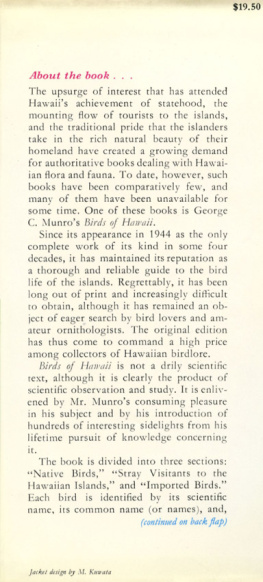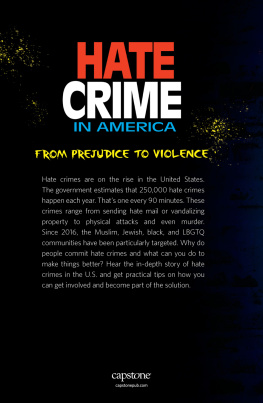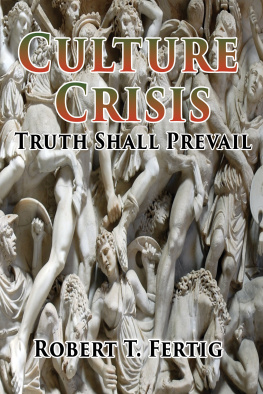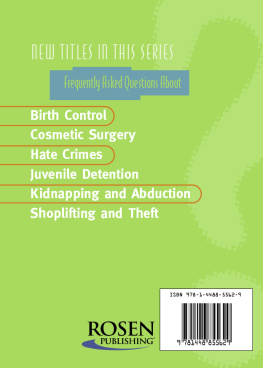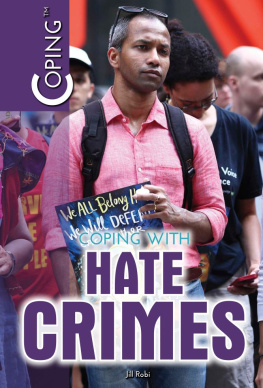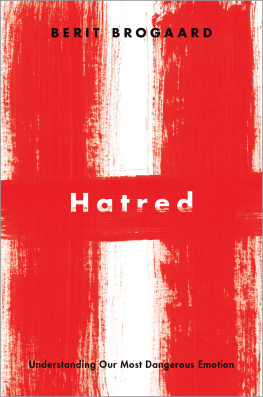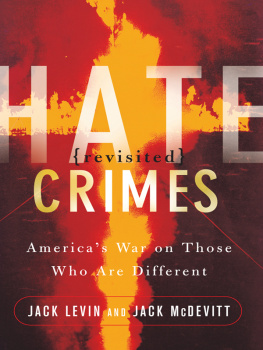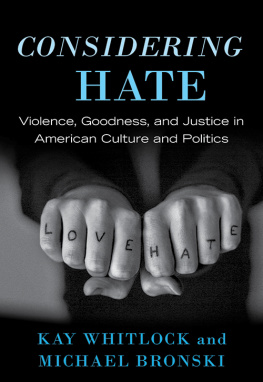Hate Crime in the Media
A History
Victoria Munro

Copyright 2014 by Victoria Munro
All rights reserved. No part of this publication may be reproduced, stored in a retrieval system, or transmitted, in any form or by any means, electronic, mechanical, photocopying, recording, or otherwise, except for the inclusion of brief quotations in a review, without prior permission in writing from the publisher.
Library of Congress Cataloging-in-Publication Data
Munro, Victoria.
Hate crime in the media : a history / Victoria Munro.
pages cm (Crime, media, and popular culture)
Includes bibliographical references and index.
ISBN 9780313356223 (hardback : alk. paper) ISBN 9780313356230 (ebook) 1. Hate crimesUnited States. 2. Mass media and cultureUnited States. I. Title.
HV6773.52.M86 2014
070.449364150973dc23 2014004390
ISBN: 9780313356223
EISBN: 9780313356230
18 17 16 15 14 1 2 3 4 5
This book is also available on the World Wide Web as an eBook.
Visit www.abc-clio.com for details.
Praeger
An Imprint of ABC-CLIO, LLC
ABC-CLIO, LLC
130 Cremona Drive, P.O. Box 1911
Santa Barbara, California 93116-1911
This book is printed on acid-free paper 
Manufactured in the United States of America
Recent Titles in Crime, Media, and Popular Culture
Black Demons: The Medias Depiction of The African American Male
Dennis Rome
Cybercrime: Criminal Threats from Cyberspace
Susan W. Brenner
Death Row Women: Murder, Justice, and the New York Press
Mark Gado
Famous American Crimes and Trials
Edited by Frankie Y. Bailey and Steven Chermak
Killer Priest: The Crimes, Trial, and Execution of Father Hans Schmidt
Mark Gado
Media Representations of September 11
Edited by Steven Chermak, Frankie Y. Bailey, and Michelle Brown
Public Executions: The Death Penalty and the Media
Christopher S. Kudac
Scottsboro and Its Legacy: The Cases that Challenged American Legal and Social Justice
James R. Acker
Contents
Series Foreword
We are pleased to introduce this volume as the latest entry in Praegers interdisciplinary series on crime, media, and popular culture. This series provides a home for scholars who are engaged in research on crime and mass media issues. The authors in this series tackle tough, often hot button issues related to the pervasiveness of media in our lives and the nature of social discourse. Ranging across many broad themes, the books in this series have explored topics including high-profile criminal cases, media coverage of 9/11, surveillance, and racial stereotypes.
In this volume, Victoria Munro focuses on hate crime in the media. Since the first contacts between racial/ethnic groups on the North American continent, the clash of cultures and belief systems has provided fertile ground for stereotyping of Others. These stereotypes were used as the rationales for dominance, control, and exploitation of land and labor. The evolving social, political, and economic institutions of the colonies and later the United States created and institutionalized inequities. In the United States and elsewhere in the world, fear and loathing of those who were different and who were in the way of progress was expressed both in political and social discourse and in physical aggression.
In the nineteenth century, mass media in the United States came into its own with the proliferation of print and, later, visual media. The themes of popular culture were echoed and expanded in the pages of the penny press, dime novels, and other publications aimed at working-class audiences. By the end of the century, photographers were capturing images of the lives of the other half who occupied the tenements of the cities. The arrival of migrants (African Americans from the rural South) and a new wave of European immigrants (Irish fleeing the potato famine) in the cities of America brought conflicts not only among these two groups who were competing for jobs, but with white nativists who viewed both groups with disdain. By the early twentieth century, the influx of Polish and Italian immigrants from eastern Europe who neither spoke English nor were Protestant spurred the expansion of the anti-immigration policies that were first applied to the Chinese in the late nineteenth century. These policies sometimes worked to the advantage of Africans Americans who left the South during the Great Migration of African Americans between the two world wars. But for black Americans, the process of assimilation was even more treacherous than for the foreign newcomers. By the early twentieth century, all of these groups had experienced the power of mass media as a vehicle for the proliferation of negative stereotypes. The caricatures of racial/ethnic groups in newspapers, pulp fiction, films, radio, and advertising reinforced the negative perceptions held by those who were deciding if these racial/ethnic minorities could be assimilated into the American mainstream. In the pages of popular fiction, in newspapers, and in films, vigilante groups such as the Ku Klux Klan sometimes emerged as defenders of white dominance, white womanhood, and the status quo.
In this volume, Munro provides the historical context for understanding hate and bias-related acts in American society, from individual acts of violence to the treatment of designated enemies during times of war. As she documents, race/ethnicity has been only one of the forms of otherness that has inspired acts of violence. To the extent that white, male, Protestant, heterosexual has been normative in American society, those of other gender, religion, and sexuality have been subject to suspicion, discrimination, and bias-related aggression. Munros analysis of the role of media in public discourse illustrates how the struggle for space and place by these other Americans has been viewed.
In her introduction to this volume, Munro provides an overview of cases that have been important in the formation of policies dealing with hate- or biased-related crimes. At the same time, she makes the point that these crimes are not a phenomenon of the past. Like war, which generates hate-based crimes on a larger scale, individual bias-related crimes are not easily eradicated because they depend on often irrational beliefs. In the chapters that follow, Munro explores the past and the present of such violence and its depiction in the media.
In her final chapter, before offering her conclusions, Munro examines the language of hate that supports the stigmatization of others. As she notes, this language has become so much a part of American culture that it is often used casually and dismissed as only joking. This language has entered the discourse of both traditional and new media forums found on the Internet. In the context of the First Amendment free speech protections, the debate continues about language as the equivalent of a physical assault on the target.
The relevance of Munros volume to contemporary life is illustrated by the frequent appearance in the media of stories about cases of violence directed toward individuals and groups that are identified as Others by the aggressors. In these cases, the media report the questions posed by law enforcement and the public about whether such acts rise to the level of hate crimes. As this foreword is being written, cases in the news include assaults and murder. The media also report on acts of bullying that cause victims emotional distress and are sometimes factors in suicides by victims.



